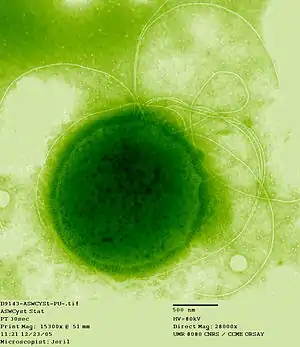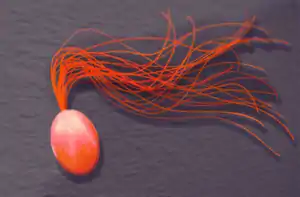Thermococci
Die Thermococci (deutsch „Thermokokken“, Synonym Protoarchaea[2]) sind eine Klasse von Archaeen im Phylum Euryarchaeota. Die Thermococcales bilden eine allgemein anerkannte Ordnung (Biologie) innerhalb der Thermococci.[3][4][5][6][7]
| Thermococci | ||||||
|---|---|---|---|---|---|---|

Thermococcus gammatolerans | ||||||
| Systematik | ||||||
| ||||||
| Wissenschaftlicher Name | ||||||
| Thermococci | ||||||
| Zillig & Reysenbach 2002[1] |

Thermococcales
Die Ordnung Thermococcales umfasst nur die Familie Thermococcaceae mit ca. 40 oder mehr Spezies (Arten), was sie zu einer der zahlreichsten Familie in der Domäne der Archaeen macht, wobei bisher wahrscheinlich nur ein kleiner Teil der natürlich vorkommenden Arten dieser Gruppe untersucht ist.[8] Diese Organismen sind hyperthermophil, d. h. sie leben in extrem heißen Umgebungen (z. B. in Hydrothermalquellen) bei optimalen Wachstumstemperaturen von über 80 °C.[1] In solchen marinen Umgebungen sind sie weit verbreitet. Thermococci gehören zu den am häufigsten isolierten Organismen aus hydrothermalen Schloten in der Tiefsee. Vertreter wurden auch aus Ölfeldvorkommen und flachen hydrothermalen Meeresgebieten isoliert, allerdings noch nie von hydrothermalen Quellen an Land. Bei Ausbrüchen unterseeischer Vulkane wurden Thermococci in hohen Konzentrationen im umgebenden Meerwasser nachgewiesen.
Die Gattungen Thermococcus und Pyrococcus (wörtlich „Wärmeball“ und „Feuerball“) sind beide obligat anaerobe Chemoorganotrophe. Thermococcus bevorzugt 70–95 °C und Pyrococcus 70–100 °C.[9][10] Thermococcus gammatolerans wurde beispielsweise im Guaymas-Becken entdeckt und wächst bei Temperaturen von 55–95 °C (optimale 88 °C) bei einem optimalen pH-Wert von 6. Diese Spezies (Art) hat eine ausgeprägte Strahlungsresistenz und kann Gammastrahlung von 30 kGy (Kilo-Gray) überleben.[11] Vertreter der Gattung Thermococcus wurden auch in terrestrischen hydrothermalen Gewässern in Neuseeland gefunden.[12] Palaeococcus helgesonii aus dem Tyrrhenischen Meer ist ein aerober chemoheterotropher Organismus, der bei Temperaturen von 45–85 °C (optimal 80 °C) wächst.[13][14] Mit Stand 2012 lagen keine Daten zur Besiedlung von Thermokokken Niedrigtemperatur-Ökosystemen sowie in Umgebungen mit hohem oder niedrigem pH-Wert vor.[8]
Methanophastidiosales
Methanophastidiosales[15] ist eine vorgeschlagene Bezeichnung für eine Gruppe von Euryarchaeota im taxonomischen Rang einer Ordnung, die ursprünglich WSA2 oder Arc I genannt wurde. Diese Archaeen gelten als die ersten entdeckten Methanbildner, das sich auf die Methanogenese durch Reduktion von methyliertem Thiol beschränken. Genomanalysen zeigen, dass ihnen Stoffwechselwege zur Kohlenstofffixierung, Stickstofffixierung und Biosynthese vieler Aminosäuren fehlen. Als Kohlenstoffquelle können sie Acetat, Malonat und Propionat verwenden.[16]
Diese Archaeen finden sich in brackigen Meeressedimenten, hydrothermalen Sedimenten, mesophilen anaeroben Fermentern, in Kläranlagenwasser und -sedimenten, Deponiesickerwasser, erdölkontaminiertem Grundwasser usw.[16]
Die Taxonomie dieser Gruppe als Ordnung der Klasse Thermococci ist noch in der Diskussion; eine andere Klassifizierung ist als eigene Klasse Methanofastidiosa[17] innerhalb einer Stenosarchaea genannten Euryarchaeota-Klade.[18]
Systematik
Mit Stand Dezember 2021 hat die Klasse Thermococci die eine allgemein akzeptierte Ordnung Thermococcales;[6][4][7] zudem wurde vorgeschlagen, eine weitere Ordnung Methanofastidiosales in die Klasse aufzunehmen:[19][15]
Klasse Thermococci Zillig & Reysenbach 2002
mit Synonym Protoarchaea Cavalier-Smith 2002[2]
- Ordnung Thermococcales Zillig 1988
- Familie Thermococcaceae Zillig 1988
- Gattung Palaeococcus Takai et al. 2000
- Spezies P. ferrophilus Takai et al. 2000
- Spezies P. helgesonii Amend et al. 2006
- Spezies P. pacificus Zeng et al. 2013
- Gattung Pyrococcus Fiala & Stetter 1986
- Spezies P. furiosus Fiala & Stetter 1986
- Spezies P. glycovorans Barbier et al. 1999
- Spezies P. orikoshii González et al. 1999
- Spezies P. kukulkanii Callac et al. 2016
- Spezies P. woesei Zillig Zillig 1988
- Spezies P. yayanosii Birrien et al. 2011
- Gattung Thermococcus Zillig 1983
- Spezies T. acidaminovorans Dirmeier et al. 2001
- Spezies T. aciditolerans Li et al. 2021
- Spezies T. aegaeus corrig. Arab et al. 2000 (mit Schreibvariante T. aegaeicus)
- Spezies T. aggregans Canganella et al. 1998
- Spezies T. alcaliphilus Keller et al. 1997
- Spezies T. atlanticus Cambon-Bonavita et al. 2004
- Spezies T. barophilus Marteinsson et al. 1999
- Spezies T. barossii Duffaud et al. 2005
- Spezies T. camini Courtine et al. 2021
- Spezies T. celer Zillig 1983
- Spezies T. celericrescens Kuwabara et al. 2007
- Spezies T. chitonophagus Huber & Stetter 1996
- Spezies T. cleftensis Hensley et al. 2014
- Spezies T. coalescens Kuwabara et al. 2005
- Spezies T. eurythermalis Zhao et al. 2015
- Spezies T. fumicolans Godfroy & Meunier 1996
- Spezies T. gammatolerans Jolivet et al. 2003
- Spezies T. gorgonarius Miroshnichenko et al. 1998[12]
- Spezies T. guaymasensis Canganella et al. 1998
- Spezies T. henrietii Alain et al. 2021
- Spezies T. hydrothermalis Godfroy et al. 1997
- Spezies T. indicus Godfroy Lim et al. 2021
- Spezies T. kodakarensis corrig. Atomi et al. 2005 (mit Schreibvariante T. kodakaraensis, ehemals Pyrococcus sp. KOD1)[20][21][22]
- Spezies T. litoralis Neuner et al. 2001
- Spezies T. pacificus Miroshnichenko et al. 1998[12]
- Spezies T. paralvinellae Hensley et al. 2014
- Spezies T. peptonophilus González et al. 1996
- Spezies T. piezophilus Dalmasso et al. 2017
- Spezies T. prieurii Gorlas et al. 2013
- Spezies T. profundus corrig. Kobayashi & Horikoshi 1995
- Spezies T. sibiricus Miroshnichenko et al. 2001
- Spezies T. siculi Grote et al. 2000
- Spezies T. stetteri Miroshnichenko 1990
- Spezies T. thioreducens Pikuta et al. 2007
- Spezies T. waiotapuensis González et al. 2001
- Spezies T. zilligii Ronimus et al. 1999
- ?Ordnung Methanofastidiosales[19]
Typus-Taxa sind fett hervorgehoben. Abgesehen von der Gattung Ca. Methanofastidiosum sind hier nur als gesichert gelistete Spezies angegeben.
Eine alternative Zuordnung der Gattung Ca. Methanofastidiosum geschieht nach LPSN und NCBI in eine eigene Klasse Ca. Methanofastidiosa corrig. Nobu et al. 2016, Klade Stenosarchaea Aouad et al. 2018 innerhalb der Euryarchaeota.[17][18]
Literatur
- Carl R. Woese, Otto Kandler, Mark L. Wheelis: Towards a natural system of organisms: proposal for the domains Archaea, Bacteria, and Eucarya. In: Proc. Natl. Acad. Sci. USA. 87, Nr. 12, 1990, S. 4576–4579. bibcode:1990PNAS...87.4576W. doi:10.1073/pnas.87.12.4576. PMID 2112744. PMC 54159 (freier Volltext).
- Christian Rinke, Maria Chuvochina, A. J. Mussig, Pierre-Alain Chaumeil, David W. Waite, W. B. Whitman, Donovan H. Parks, Philip Hugenholtz: A rank-normalized archaeal taxonomy based on genome phylogeny resolves widespread incomplete and uneven classifications, auf: CSH BioRxiv, 3. März 2020, doi:10.1101/2020.03.01.972265, Meta.org, ResearchGate (Preprint)
Einzelnachweise
- Wolfram Zillig, Anna-Louise Reysenbach: Class IV (sic) [V]. Thermococci class. nov.. In: D. R. Boone, R. W. Castenholz (Hrsg.): Bergey's Manual of Systematic Bacteriology Volume 1: The Archaea and the deeply branching and phototrophic Bacteria, 2nd. Auflage, Springer Verlag, New York 2001, ISBN 978-0-387-98771-2, S. 169.
- Thomas Cavalier-Smith: The neomuran origin of archaebacteria, the negibacterial root of the universal tree and bacterial megaclassification. In: Int. J. Syst. Evol. Microbiol., Band 52, Nr. Pt 1, Januar 2002, S. 7–76, doi:10.1099/00207713-52-1-7, PMID 11837318
- George M. Garrity, John G. Holt: Phylum AII. Euryarchaeota phy. nov.. In: D. R. Boone, R W Castenholz (Hrsg.): Bergey's Manual of Systematic Bacteriology Volume 1: The Archaea and the deeply branching and phototrophic Bacteria, 2nd. Auflage, Springer Verlag, New York 2001, ISBN 978-0-387-98771-2, S. 169. Hier S. 169.
- NCBI: Thermococci und Thermococci Zillig and Reysenbach 2002 (class); graphisch: Thermococci, auf: LifeMap NCBI Version.
- Thermococci, auf: OneZoom
- LPSN: Thermococci Zillig and Reysenbach 2002
- WoRMS: Thermococci (Bitte den Schalter „marine only“ deaktivieren)
- G. B. Slobodkina (Г. Б. Слободкина): Молекулярная детекция представителей гипертермофильных архей и характеристика архейной термостабильной ДНК-полимеразы Архивировано (Molecular detection of representatives of hyperthermophilic archaea and characterization of archaeal thermostable DNA polymerase), Dissertation im Bereich Biowissenschaften, 2005, 188 Seiten, archiviert/Epub 9. März 2012, (russisch)
- Gerhard Fiala, Karl O. Stetter: Pyrococcus furiosus sp. nov. represents a novel genus of marine heterotrophic archaebacteria growing optimally at 100°C. In: Archives of Microbiology, Band 145, Juni 1986, S. 56–61, doi:10.1007/BF00413027.
- Evelyne Marguet, Marie Gaudin, Emilie Gauliard, Isabelle Fourquaux, Stephane le Blond du Plou, Ikuo Matsui, Patrick Forterre: Membrane vesicles, nanopods and/or nanotubes produced by hyperthermophilic archaea of the genus Thermococcus. In: Biochem Soc Trans, Band 41, Nr. 1, 29. Januar 2013, S. 436–442, doi:10.1042/BST20120293, PMID 23356325.
- Edmond Jolivet, Stéphane L'Haridon, Erwan Corre, Patrick Forterre, Daniel Prieur: Thermococcus gammatolerans sp. nov., a hyperthermophilic archaeon from a deep-sea hydrothermal vent that resists ionizing radiation. In: Int. J. Syst. Evol. Microbiol., Band 53, Nr. Pt 3, Mai 2003, S. 847–851, doi:10.1099/ijs.0.02503-0, PMID 12807211.
- Margarita L. Miroshnichenko, Gregory M. Gongadze, Fred A. Rainey, Alla S. Kostyukova, Anatoly M. Lysenko, Nikolai Alexeevitch Chernyh, Elizaveta A. Bonch-Osmolovskaya: Thermococcus gorgonarius sp. nov. and Thermococcus pacificus sp. nov.: heterotrophic extremely thermophilic archaea from New Zealand submarine hot vents. In: Int. J. Syst. Bacteriol., Band 48, Nr. Pt 1, 1. Januar 1998, S. 23–29, doi:10.1099/00207713-48-1-23, PMID 9542072.
- Jan P. Amend, D'Arcy R. Meyer-Dombard, Seema N. Sheth, Natalya Zolotova, Andrea C. Amend: Palaeococcus helgesonii sp. nov., a facultatively anaerobic, hyperthermophilic archaeon from a geothermal well on Vulcano Island, Italy. In: Archives of Microbiology, Band 179, Nr. 6, April/Juni 2003, S. 394–401, doi:10.1007/s00203-003-0542-7.
- K. L. Rogers, Jan P. Amend: Archaeal diversity and geochemical energy yields in a geothermal well on Vulcano Island, Italy. In: Geobiolog, Band 3, Nr. 4, Oktober 2005/3. März 2006, S. 319–332, doi:10.1111/j.1472-4669.2006.00064.x
- Genome Database (GTDB): Thermococci
- Masaru Konishi Nobu, Takashi Narihiro, Kyohei Kuroda, Ran Mei, Wen-Tso Liu: Chasing the elusive Euryarchaeota class WSA2: genomes reveal a uniquely fastidious methyl-reducing methanogen. In: Nature ISME Journal, Band 10, Nr. 10, Oktober 2016, S. 2478–2487, doi:10.1038/ismej.2016.33, PMC 5030686 (freier Volltext), PMID 26943620, Epub 4. März 2016.
- LPSN: Genus "Candidatus Methanofastidiosum"
- NCBI: "Candidatus Methanofastidiosum" Nobu et al. 2016 (genus); graphisch: Candidatus Methanofastidiosum, auf: LifeMap NCBI Version.
- Midas: Methanofastidiosales
- Haruyuki Atomi, Toshiaki Fukui, Tamotsu Kanai, Masaaki Morikawa, Tadayuki Imanaka: Description of Thermococcus kodakaraensis sp. nov., a well studied hyperthermophilic archaeon previously reported as Pyrococcus sp. KOD1. In: Archaea, Band 1, Nr. 4, Oktober 2004, S. 263–267, doi:10.1155/2004/204953, PMC 2685570 (freier Volltext), PMID 15810436, Epub 16. April 2004.
- Wakao Fukuda, Yulia Sari Ismail, Toshiaki Fukui, Haruyuki Atomi, Tadayuki Imanaka: Characterization of an archaeal malic enzyme from the hyperthermophilic archaeon Thermococcus kodakaraensis KOD1. In: Archaea, Band 1, Nr. 5, Mai 2005,S. 293–301, doi:10.1155/2005/250757, PMID 15876562, PMC 2685551 (freier Volltext).
- Toshiaki Fukui, Haruyuki Atomi, Tamotsu Kanai, Rie Matsumi, Shinsuke Fujiwara, Tadayuki Imanaka: Complete genome sequence of the hyperthermophilic archaeon Thermococcus kodakaraensis KOD1 and comparison with Pyrococcus genomes. In: CSH Press Genome Research, Band 15, Nr. 3, März 2005, S. 352–363, doi:10.1101/gr.3003105, PMID 15710748, PMC 551561 (freier Volltext), Epub 14. Februar 2005.
- Midas: Genus: Candidatus Methanofastidiosum. Alternative Names: WCHA1–57. Microbial Database for Activated Sludge and Anaerobic Digesters, Universität Aalborg (AAU), Dänemark.
- Stefano Fazi et al.: High concentrations of dissolved biogenic methane associated with cyanobacterial blooms in East African lake surface water. In: Nature Communications, Band 4, Nr. 845, 7. Juli 2021, doi:10.1038/s42003-021-02365-x.
